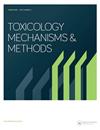两种新型乙酰胆碱酯酶再激活剂K920和K923和肟K203和曲马多肟对塔本中毒大鼠神经保护作用的比较
IF 2.7
4区 医学
Q2 TOXICOLOGY
引用次数: 1
摘要
摘要使用功能观察电池(FOB),将两种新开发的双吡啶肟(K920、K923)减少他本诱导的急性神经毒性体征和症状的能力与肟K203和曲马多肟进行了比较。肟与阿托品联合应用对亚致死剂量(130 μg/kg腹腔注射。;LD50值的80%)。2时通过FOB监测塔本引起的神经毒性 h给药后。结果表明,所有测试的肟与阿托品联合使用都能使塔本中毒大鼠存活到实验结束,而一只未经治疗的塔本中毒鼠在2小时内死亡 h.两种新开发的肟(K920、K923)与阿托品联合使用,在亚致死性中毒的情况下,都能显著降低塔本诱导的神经毒性,尽管它们不能消除塔本诱发的所有急性神经毒性体征和症状。它们降低塔本诱导的急性神经毒性的能力不如曲马多肟和肟K203的神经保护作用。因此,新开发的肟不适合取代目前可用的肟(尤其是曲马多肟)治疗急性塔本中毒。本文章由计算机程序翻译,如有差异,请以英文原文为准。
A comparison of neuroprotective efficacy of two novel reactivators of acetylcholinesterase called K920 and K923 with the oxime K203 and trimedoxime in tabun-poisoned rats
Abstract The ability of two newly developed bispyridinium oximes (K920, K923) to reduce tabun-induced acute neurotoxic signs and symptoms was compared with the oxime K203 and trimedoxime using a functional observational battery (FOB). The neuroprotective effects of the oximes studied combined with atropine on rats poisoned with tabun at a sublethal dose (130 μg/kg i.m.; 80% of LD50 value) were evaluated. Tabun-induced neurotoxicity was monitored by FOB at 2 h after tabun administration. The results indicate that all tested oximes combined with atropine enable tabun-poisoned rats to survive till the end of experiment while one non-treated tabun-poisoned rat died within 2 h. Both newly developed oximes (K920, K923) combined with atropine were able to markedly decrease tabun-induced neurotoxicity in the case of sublethal poisoning although they did not eliminate all tabun-induced acute neurotoxic signs and symptoms. Their ability to decrease tabun-induced acute neurotoxicity did not prevail the neuroprotective efficacy of trimedoxime and the oxime K203. Therefore, the newly developed oximes are not suitable for the replacement of currently available oximes (especially trimedoxime) in the treatment of acute tabun poisonings.
求助全文
通过发布文献求助,成功后即可免费获取论文全文。
去求助
来源期刊

Toxicology Mechanisms and Methods
TOXICOLOGY-
自引率
3.10%
发文量
66
期刊介绍:
Toxicology Mechanisms and Methods is a peer-reviewed journal whose aim is twofold. Firstly, the journal contains original research on subjects dealing with the mechanisms by which foreign chemicals cause toxic tissue injury. Chemical substances of interest include industrial compounds, environmental pollutants, hazardous wastes, drugs, pesticides, and chemical warfare agents. The scope of the journal spans from molecular and cellular mechanisms of action to the consideration of mechanistic evidence in establishing regulatory policy.
Secondly, the journal addresses aspects of the development, validation, and application of new and existing laboratory methods, techniques, and equipment. A variety of research methods are discussed, including:
In vivo studies with standard and alternative species
In vitro studies and alternative methodologies
Molecular, biochemical, and cellular techniques
Pharmacokinetics and pharmacodynamics
Mathematical modeling and computer programs
Forensic analyses
Risk assessment
Data collection and analysis.
 求助内容:
求助内容: 应助结果提醒方式:
应助结果提醒方式:


